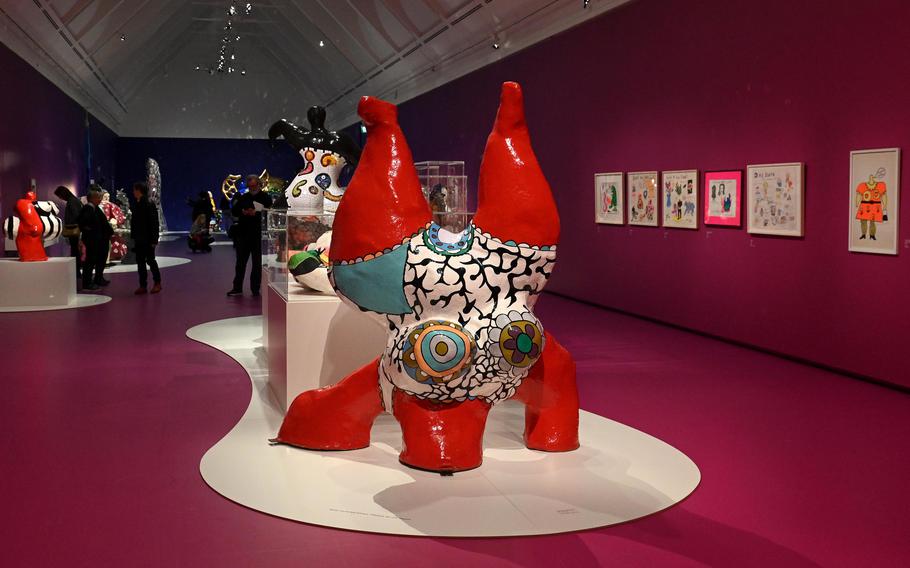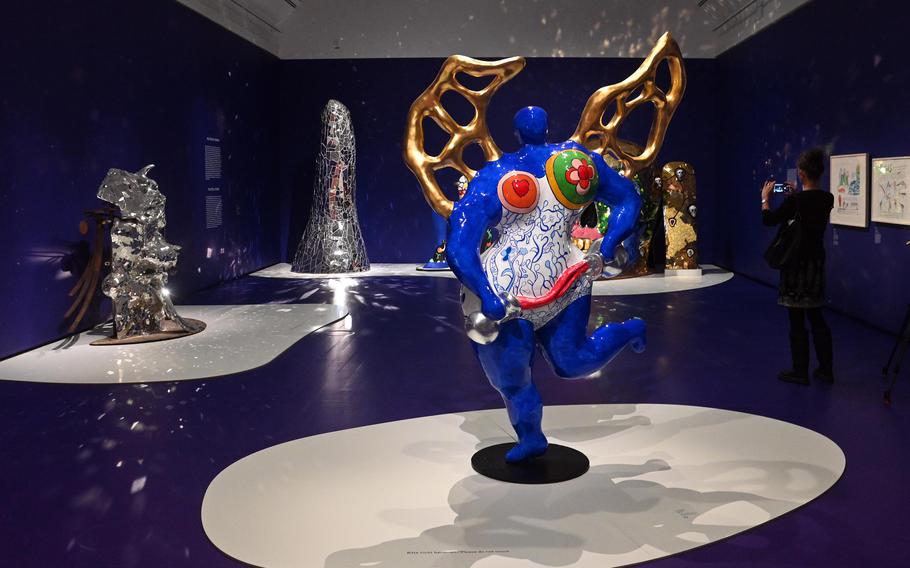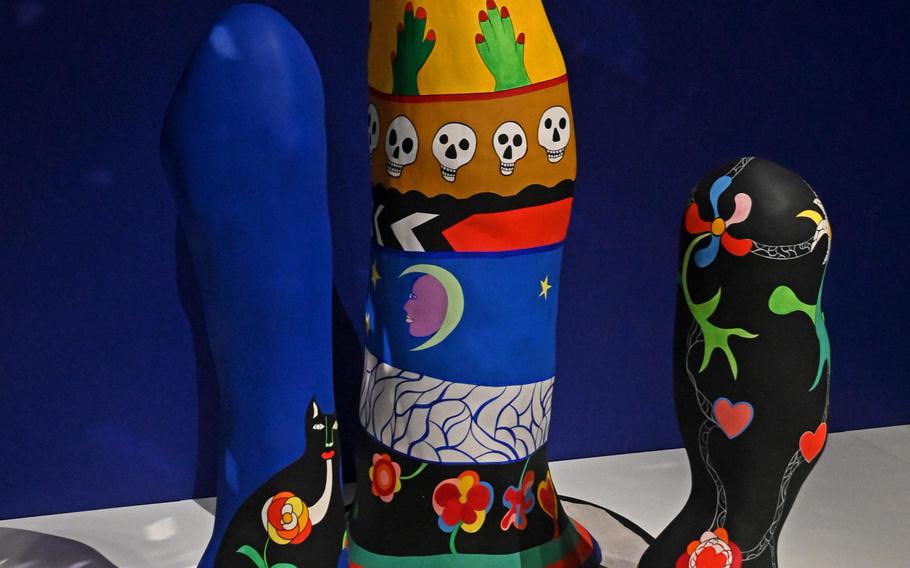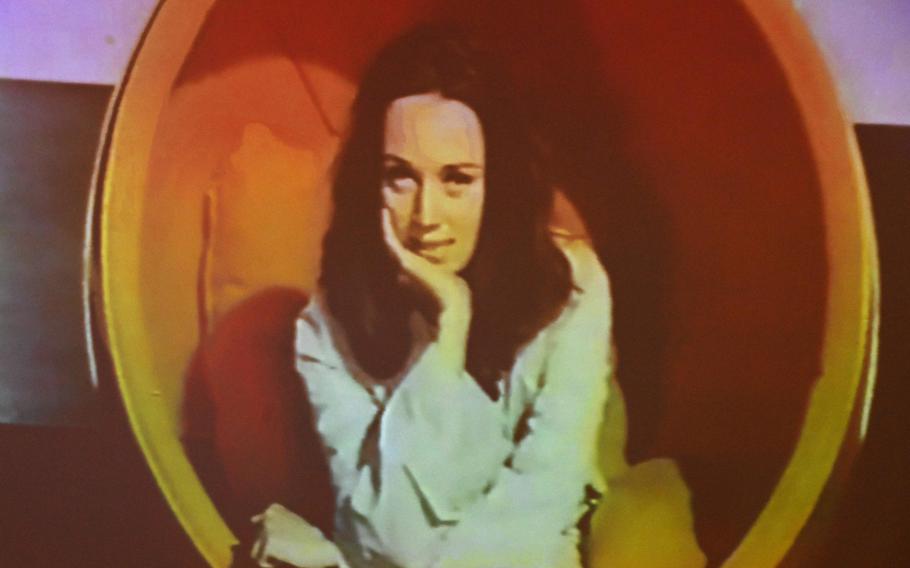
The Niki de Saint Phalle exhibit at the Schirn in Frankfurt, Germany, with one of the artist’s famous Nanas, “Red Nana Legs in the Air,” in the foreground. The exhibit runs through May 21, 2023. (Michael Abrams/Stars and Stripes)
If Niki de Saint Phalle was anything, she was a multifaceted artist.
From shooting at her works with a rifle to creating the voluptuous “Nanas” that made her famous to installing the giant walkable sculptures at Tarot Park in the Italian region of Tuscany, Saint Phalle showed an incredible pop art imagination.
This can be seen at a retrospective of her art that opened recently at the Schirn, Frankfurt’s esteemed exhibition hall. The exhibit runs through May 21.

The Schirn exhibition hall in Frankfurt, Germany, is showing a Niki de Saint Phalle retrospective through May 21, 2023. In the foreground is her colorful work “Angel of Temperance.” (Michael Abrams/Stars and Stripes)
Saint Phalle was born in France in 1930 but grew up in the U.S. She returned to Europe with her first husband and daughter in 1952, living in Paris.
After spending time in a sanatorium with mental health issues, she began painting a year later. From then until her death in 2002, Saint Phalle went on to become one of the big movers on the European pop art scene.
The Schirn exhibit, with about 100 works on display, takes you through all the phases of her career, but not necessarily in chronological order.
It begins with her “shooting pictures,” where balloons filled with paint and other objects are attached to one of her works, then shot at with a rifle, splattering the piece with color.
At whom is she shooting? Her father, who sexually abused her as a child? Her brother? Men in general? Herself? It is not clear, even to her, but women would be a centerpiece of her work for the rest of her life.
She also had fellow artists and the public take aim at her works, creating art happenings.
The main exhibition room shows her early paintings, including the oversized “King Kong,” adorned with masks of President John F. Kennedy, his Soviet adversary Nikita Khrushchev, former Cuban leader Fidel Castro and Santa Claus, and children playing with a ball and a giant spider, among other things.
Next to it, her Iife-size “Bride on Horse” grabs visitors’ attention. Across the room are such works as “The Castle of the Monster and the Bride (or The Sunken Wedding)” and “Play with Me,” while at the center are two of her famed “Nanas.”
On a side note, many people, including me, were introduced to Saint Phalle’s art through her sculptures in the Stravinsky Fountain in front of the Centre Pompidou in Paris.
While playful and colorful, a Nana is Saint Phalle’s statement on how men looked at women, at least during the last century: voluptuous but with either a small head or no head at all.
The exhibit features two other works depicting her view of mid-20th century women. They are “The Grooming,” a woman using her daily toiletries in front of a mirror, and “Tea Party,” two rather unattractive women having tea.
Also on display are models Saint Phalle created while planning her Tarot Park, which features 22 giant sculptures on a hill at a former quarry near Garavicchio, Italy. Many of them are so big that you can walk inside.

Niki de Saint Phalle’s work “Trilogy of Obelisks” is on exhibit at a show dedicated to the artist at the Schirn in Frankfurt, Germany. (Michael Abrams/Stars and Stripes)
Especially in her later years, Saint Phalle was a political activist, creating works of art that focused on the AIDS epidemic, gun control, abortion rights and the environment.
These works wrap up the Schirn’s exhibit on one of the most imaginative artists of the mid- to late 20th century.

The artist Niki de Saint Phalle seen in a video before you enter the exhibit dedicated to her, at the Schirn in Frankfurt, Germany, through May 21, 2023. (Michael Abrams/Stars and Stripes)
On the QT
Location: Roemerberg in Frankfurt. By car, follow signs to Parkbereich D, Dom/Roemer. The garage here costs 2 euros per hour and 1 euro per hour on Sundays and holidays. On public transportation, take subway lines 4 and 5 to the Dom/Roemer stop. Tram lines 11 and 12 stop at the nearby Paulskirche.
Hours: Tuesday and Sunday, 10 a.m.-7 p.m.; Wednesday through Saturday, 10 a.m.-10 p.m.; closed Mondays.
Cost: 12 euros for adults and 10 euros for children 8-17 on weekdays; 14 euros and 12 euros, respectively, on weekends. A family ticket, valid for one or two adults and children 17 and under, costs 24 euros on weekdays and 28 euros on weekends.
Information: The Chagall exhibit closes Feb. 19. The English artist Monster Chetwynd’s installation “A Cat is not a Dog” is on exhibit in the rotunda starting March 3, and an exhibit of works by Turner Prize winner Elizabeth Price opens March 23. Tickets and other services available at schirn.de.